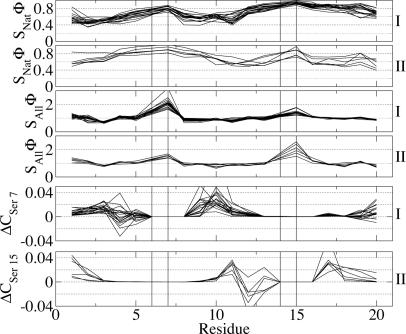Fig. 5.
Heterogeneity and nonnative structure of TS. The labels on the right indicate mutants with the C-terminal β-hairpin more structured at the TS (I) and mutants with the N-terminal β-hairpin more structured at the TS (II). Each solid curve corresponds to a single-point mutant and the lines are drawn to help the eye. Vertical lines indicate the position of the G6-S7 and G14-S15 turns. In the first four rows, the structural Φ values (SNat Φ and SAll Φ) are the ratio between the number of contacts formed in the TS and native state. SNat Φ takes into account only native contacts, whereas SAll Φ also includes nonnative contacts at the TS and can assume values >1. In the last two rows, ΔCX(R) =Σi ∈ C(X,R) [pTS(i) - pN(i)] is the difference between the contacts formed in the TS and in the native state between residue X and R. Positive values indicate that in the TS, there are more contacts than in the native state. Both S7 and S15, if the corresponding hairpin is not native (i.e., in the class of mutants I and II, respectively), have a larger number of contacts in the TS than in the native state with K9 and the residue in position 10, and K17 and the residue in position 18, respectively. A smaller number of contacts in the TS than in the native state is observed with Q4 and Q12, respectively.

